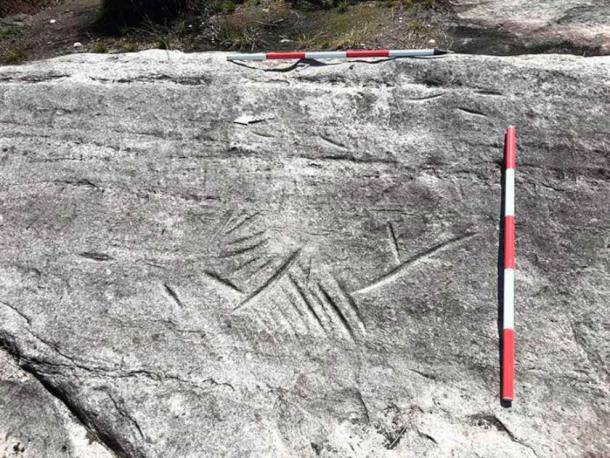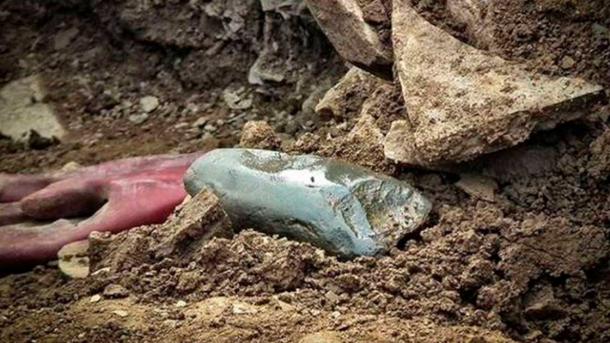Archaeologists and volunteers examining a 4,500-year-old Neolithic site near Balfron, beside Stirling in Central Scotland, recently rolled back turf and revealed a giant slab of sandstone. Marked with a series of deep channels, it is believed the stone was used like a whetstone to polish axes. The site now represents the largest concentration of Neolithic axe grind points ever discovered in Scotland.
An article on Ancient Pages explained that the site is one of only two known Scottish “polissoir” (U-shaped groove) sites. And so important was this location in the Neolithic period that the archeologists believe “people may have travelled for many miles to smooth or sharpen axes at the site.”
An Axe-Grinding Stone for those with an Axe to Grind
During the summer of 2022 a team of volunteers assisted archaeologists in discovering 33 U-shaped grooves, known as polissoirs, at the site near Balfron in Scotland. The BBC reported that Nick Parish, a volunteer from Scotland’s Rock Art Project , and Dr. Murray Cook, a Stirling Council archaeologist, helped strip back turf from the huge slab of sandstone that was last used around 4,500 years ago.
The polissoirs mark an exceptionally special place where Neolithic toolmakers “with an axe to grind” gathered to use the huge whetstone to polish stone axes . Furthermore, the archaeologists are speculating that ancient craftsmen may have travelled from many miles away to smooth or sharpen axes at this particular site in Scotland, explaining that some of the axes would have been used functionally while others were given as “ceremonial gifts.”
What do 33 Neolithic axe marks, a rare sherd of 4,000-year-old pottery and a “nationally important” medieval monastery have in common?
They’re all featured in our list of Scotland’s most amazing archaeological discoveries from 2022: https://t.co/K975yBqVbs pic.twitter.com/LpDF6yFDQG
— Dig It! (@DigItScotland) December 7, 2022
Legacy of the Ancient Foresters
The archaeological awards organisation, Dig It , recently listed this discovery in its Top Ten for 2022. Dr. Cook stressed that “discovery is at the heart of archaeology,” but that his job is mostly “just routine and the truncated, fragments of a jigsaw without the picture.” However, the researcher said “Balfron was different” and that the huge sandstone represents “the discovery of a lifetime.”
Cook said “the grooves are astonishing” and “nobody has ever seen anything like them before.” He concluded that to imagine people kneeling at the huge stone in the Neolithic period , sharpening stone axes that would clear Scotland’s primordial forests “is just mind blowing.” Scotland’s earliest hand axes were the choice tools of the first foresters who chopped away ancient wildwoods, making way for fields.

The site where archaeologists discovered a giant sandstone axe-grinding stone represents Scotland’s largest concentration of Neolithic axe grind points. ( Dr. Murray Cook )
Axes Indicate Shared Neolithic Technologies and Beliefs
The discovery of axe heads in various parts of Scotland shows that Neolithic people made them from both local and imported materials. Furthermore, the entire country was connected with Ireland through trading networks, along which axes were passed.
While many axes were undoubtedly used as practical cutting tools, most discovered are highly-polished ritual and ceremonial objects. According to Arch Highland , both utilitarian and ritual axe heads found throughout the UK and Europe, show “a shared technological and belief system.”
In 2018 BBC News reported that two polished stone axes were uncovered at the Ness of Brodgar Neolithic settlement on Orkney, off the north east of Scotland, which showed signs of heavy practical use. Site director Nick Card of the University of the Highlands and Islands said both axes were damaged “cutting timber joists.” One of them, however, was shaped “to maximize the beauty of the stone’s natural colors,” suggesting it might have had ritual significance.

A stone axe discovered at the Ness of Brodgar Neolithic settlement on Orkney in 2018. ( Ness of Brodgar Trust )
Axes Were Ancient Symbols of Power
The suspicion that this was “a ritual” axe was cemented when its context was considered. Dr. Card explained that the building in which it was discovered “was aligned to catch the first rays of the equinox sunrise.” This leads many archaeologists to believe that Neolithic axes , in addition to serving as multifunctional tools, may also have been important symbols of power used by emerging elite agricultural families.
Thus, the discovery of the huge sharpening stone in Central Scotland might mark the final point in the production process before ceremonial exes were traded far and wide, to north of Scotland and all the way to southern Europe.
Top image: A large axe-grinding stone near Balfron in Scotland is where Neolithic toolmakers sharpened stone axes thousands of years ago. Source: Dr. Murray Cook
By Ashley Cowie
 RSS Feed
RSS Feed















 December 15th, 2022
December 15th, 2022  Awake Goy
Awake Goy  Posted in
Posted in  Tags:
Tags: 













